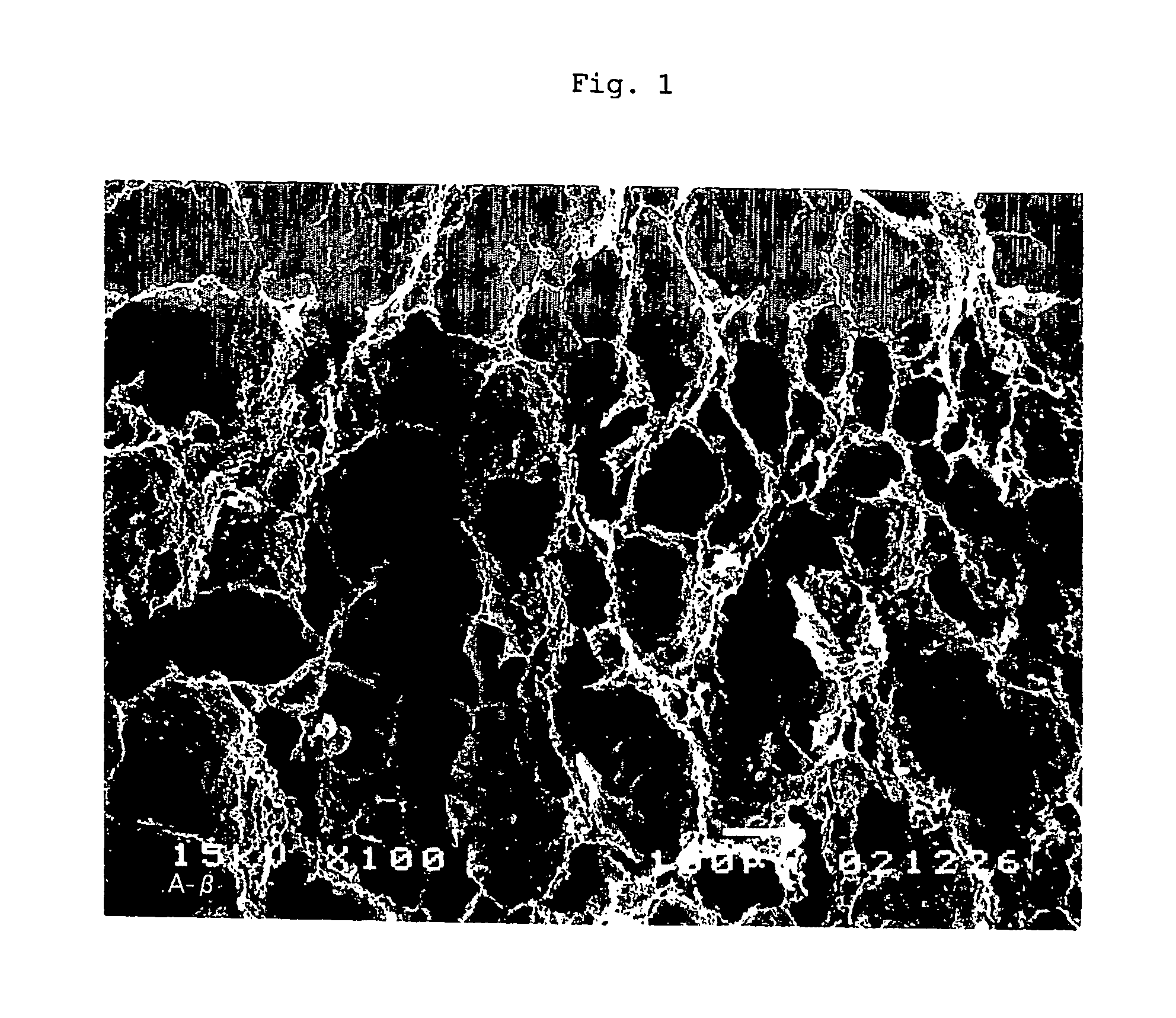Porous body, production method thereof and composite material using the porous body
a technology of porous body and fiber, which is applied in the direction of catalyst activation/preparation, synthetic resin layered products, and final product manufacturing. it can solve the problems of insufficient degree of three-dimensional network formation between fiber filaments, difficult design, and difficult preparation of prepregs of vapor grown carbon fiber. , to achieve the effect of low volumetric shrinkage, easy to manufacture and use, and easy to design
- Summary
- Abstract
- Description
- Claims
- Application Information
AI Technical Summary
Benefits of technology
Problems solved by technology
Method used
Image
Examples
example 1
[0070] Agar (1.5 g) was dissolved in purified water (50 g) under heating at 95° C., to thereby prepare a solution (the solution will be called “liquid A”). Separately, sodium dodecylbenzenesulfonate (concentration: 40 mass %, product of Aldrich) (0.45 g) was added to purified water (75 g). To the resultant mixture was added vapor grown carbon fiber (VGCF (registered trademark), product of Showa Denko K.K.; fiber diameter: 150 nm, aspect ratio: 60, specific surface area: 13 m2 / g, Raman spectrum intensity ratio: 0.15) (4.2 g). The resultant mixture was subjected to ultrasonic irradiation for 30 minutes, and then to stirring for one hour by use of a magnetic stirrer, to thereby prepare a dispersion (the dispersion will be called “liquid B”).
[0071] After being cooled to 60° C., the liquid A was mixed with the liquid B. Thereafter, the resultant mixture was frozen in a freezer at -15° C. to −20° C. Subsequently, the thus-frozen product was removed from the freezer, and placed in a freez...
example 2
[0073] The porous material produced in Example 1 was thermally treated in a tubular heating furnace under a stream of argon gas (10 L / min) at 800° C. for one hour. The thus-treated porous material was found to have a porosity of 0.98, a vapor grown carbon fiber content of 93 mass %, a specific surface area of 520 m2 / g, and a volume resistivity of 40 Ω·cm. The percent volumetric shrinkage of the porous material during thermal treatment was found to be 13 vol.%.
example 3
[0074] Agar (1.5 g) was dissolved in purified water (50 g) under heating at 95° C., to thereby prepare a solution (the solution will be called “liquid A”). Separately, sodium dodecylbenzenesulfonate (concentration: 40 mass %, product of Aldrich) (0.45 g) was added to purified water (75 g). To the resultant mixture was added vapor grown carbon fiber (VGCF (registered trademark), product of Showa Denko K.K.; fiber diameter: 150 nm, aspect ratio: 60, specific surface area: 13 m2 / g, Raman spectrum intensity ratio: 0.15) (8.5 g). The resultant mixture was subjected to ultrasonic irradiation for 30 minutes, and then to stirring for one hour by use of a magnetic stirrer, to thereby prepare a dispersion (the dispersion will be called “liquid B”).
[0075] After being cooled to 60° C., the liquid A was mixed with the liquid B. Thereafter, the resultant mixture was frozen in a freezer at -15° C. to −20° C. Subsequently, the thus-frozen product was removed from the freezer, and subjected to free...
PUM
| Property | Measurement | Unit |
|---|---|---|
| Temperature | aaaaa | aaaaa |
| Percent by mass | aaaaa | aaaaa |
| Percent by mass | aaaaa | aaaaa |
Abstract
Description
Claims
Application Information
 Login to View More
Login to View More - R&D Engineer
- R&D Manager
- IP Professional
- Industry Leading Data Capabilities
- Powerful AI technology
- Patent DNA Extraction
Browse by: Latest US Patents, China's latest patents, Technical Efficacy Thesaurus, Application Domain, Technology Topic, Popular Technical Reports.
© 2024 PatSnap. All rights reserved.Legal|Privacy policy|Modern Slavery Act Transparency Statement|Sitemap|About US| Contact US: help@patsnap.com










